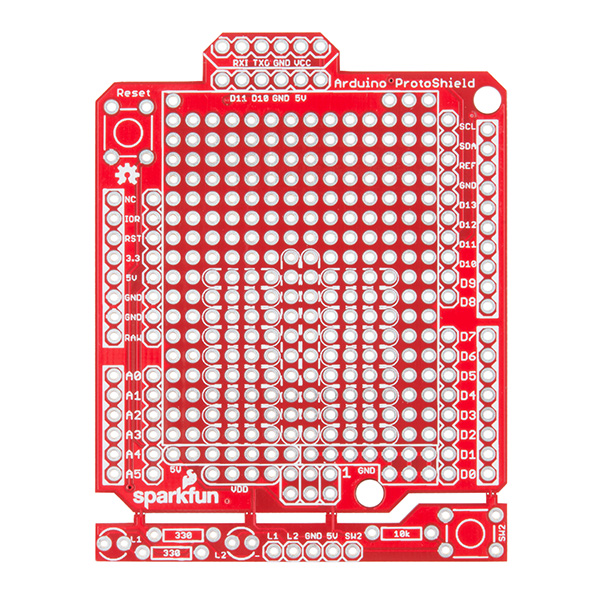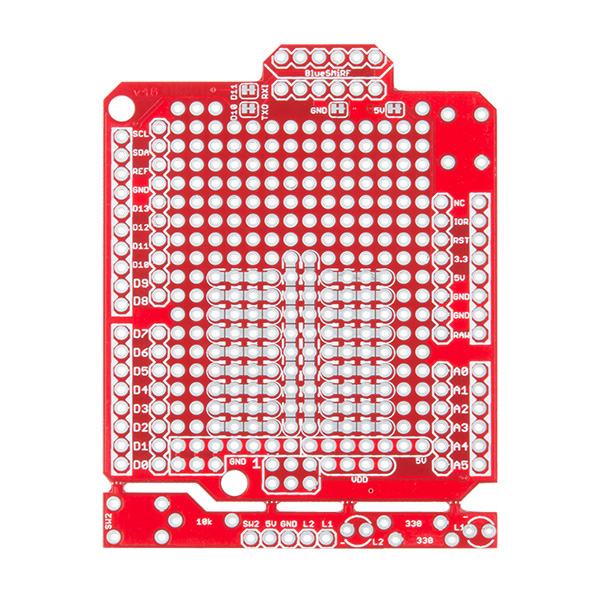SparkFun Arduino ProtoShield - Bare PCB
The SparkFun Arduino ProtoShield is a bare PCB with no attached or included parts that lets you customize your own Arduino shield using whatever circuit you can come up with! You will even be able to test your circuit or project to make sure everything is working the way it should! The SparkFun Arduino ProtoShield is based off the Arduino R3’s footprint that allows you to easily incorporate it with favorite Arduino-based device.
Now you don't need to buy the whole ProtoShield kit if you just need a piece of prototyping board that will fit on top of your Arduino. You might want to grab a stackable header kit, though, which you can find in the related items below.
One of our favorite features with this version of the Arduino ProtoShield is the solderable-like breadboard prototyping area! Half of this area was designed with a breadboard in mind. On the underside of the shield you will be able to see open jumper pads between each through hole to make a connection like a breadboard. Once you add a component, simply add a solder jumper between holes to make a connection. For those that prefer the standard prototyping pads, we left the other side (near the BlueSMiRF and Serial UART ports) as is.
We have also moved the prototype testing components (those used to make sure your circuit works effectively) off of the "mainland" of the shield and onto a ProtoSnap styled, removable PCB. On this test area you will find soldering areas for two 3mm LEDs (as well as pins to control and power them), two 330 Ohm resistors, a 10K Ohm resistor, and a pushbutton. These items you'll need to purchase separately.
- Arduino R3 Footprint
- Solderable-Like Breadboard
- BlueSMiRF or Comparable 6-pin
- Detachable Test Area
SparkFun Arduino ProtoShield - Bare PCB Product Help and Resources
SparkFun Arduino ProtoShield Hookup Guide
May 17, 2018
The SparkFun Arduino ProtoShield PCB and ProtoShield kit lets you customize your own Arduino shield using whatever custom circuit you can come up with! This tutorial will go over its features, hardware assembly, and how to use the shield with an Arduino R3 footprint.
Core Skill: Soldering
This skill defines how difficult the soldering is on a particular product. It might be a couple simple solder joints, or require special reflow tools.
Skill Level: Rookie - The number of pins increases, and you will have to determine polarity of components and some of the components might be a bit trickier or close together. You might need solder wick or flux.
See all skill levels
Core Skill: Electrical Prototyping
If it requires power, you need to know how much, what all the pins do, and how to hook it up. You may need to reference datasheets, schematics, and know the ins and outs of electronics.
Skill Level: Rookie - You may be required to know a bit more about the component, such as orientation, or how to hook it up, in addition to power requirements. You will need to understand polarized components.
See all skill levels
Comments
Looking for answers to technical questions?
We welcome your comments and suggestions below. However, if you are looking for solutions to technical questions please see our Technical Assistance page.
Customer Reviews
5 out of 5
Based on 2 ratings:
Very High Quality
I have used these boards on several projects, including a heavily used production Arduino control unit at work. The pads are double sided and very easy to solder. Better yet - I've had to desolder some components a couple of times, and the pads held up nicely.
I cannot imagine anybody being disappointed with these boards.




